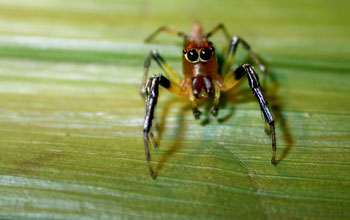Multimedia Gallery
Jumping spider (Hypaeus benignus)
A jumping spider (Hypaeus benignus) from the La Selva Biological Station in Costa Rica. H. benignus is about 7 millimeters long.
More about this Image
As part of her dissertation research, supported by a National Science Foundation graduate research fellowship, Lisa Taylor of Arizona State University's (ASU) School of Life Sciences studied mimicry in the jumping spider family Salticidae. Salticidae are the largest family of jumping spiders in the world.
In biology, mimicry is the similarity of one species to another. The mimicry may offer protection from predators for one or both of the species involved, and may help the mimic acquire food more easily. The mimicking species may be similar to the mimicked in appearance, behavior, sound, scent and location.
Currently, Taylor is studying the courtship rituals of jumping spiders. In particular, she is interested in how animals use color to communicate. In her dissertation work at ASU, she is working with a group of colorfully ornamented jumping spiders (like the ones pictured here) in the genus Habronattus. She's trying to understand how they use color to advertise themselves to potential mates and competitors, as well as to deceive and avoid potential predators. (Date of Image: 2005-2010)
Credit: Lisa Taylor, Arizona State University
See other images like this on your iPhone or iPad download NSF Science Zone on the Apple App Store.
Images and other media in the National Science Foundation Multimedia Gallery are available for use in print and electronic material by NSF employees, members of the media, university staff, teachers and the general public. All media in the gallery are intended for personal, educational and nonprofit/non-commercial use only.
Images credited to the National Science Foundation, a federal agency, are in the public domain. The images were created by employees of the United States Government as part of their official duties or prepared by contractors as "works for hire" for NSF. You may freely use NSF-credited images and, at your discretion, credit NSF with a "Courtesy: National Science Foundation" notation.
Additional information about general usage can be found in Conditions.
Also Available:
Download the high-resolution JPG version of the image. (2.5 MB)
Use your mouse to right-click (Mac users may need to Ctrl-click) the link above and choose the option that will save the file or target to your computer.

 All images in this series
All images in this series